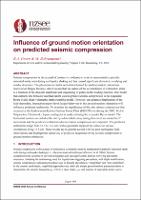Influence of ground motion orientation on predicted seismic compression
Abstract
Seismic compression is the accrual of contractive volumetric strain in unsaturated or partially saturated sandy soils during earthquake shaking and has caused significant distress to overlying and nearby structures. The phenomenon can be well-characterized by load-dependent, interaction macro-level fatigue theories, which means that the nature of the accumulation of volumetric strain is a function of the absolute amplitude and sequencing of pulses in the loading function. One model that captures this behavior and that can be used to predict seismic compression is the expanded Byrne cyclic shear-volumetric strain coupling model. However, one potential implication of the load-dependent, interaction macro-level fatigue behaviour is that ground motion orientation will influence predicted settlements. To examine the significance of this, the seismic compression that occurred at the Kashiwazaki-Kariwa Nuclear Power Plant (KKNPP) site during the 2007, Mw6.6 Niigata-ken Chuetsu-oki, Japan, earthquake is analyzed using the expanded Byrne model. The horizontal motions recorded at the site by a down-hole array during this event are rotated in 5° increments and the predicted settlements due to seismic compression are computed. The predicted settlements range from 12.3 to 16.1 cm, with a geometric mean of the values for various orientations being 13.8 cm. These results are in general accord with the post-earthquake field observations and highlight the sensitivity of predicted magnitude of the seismic compression to ground motion orientation.

